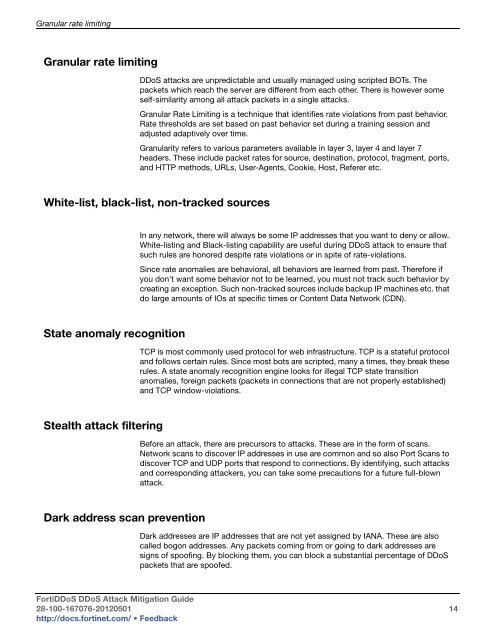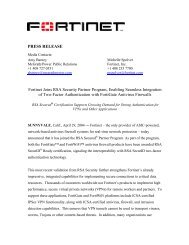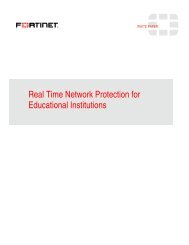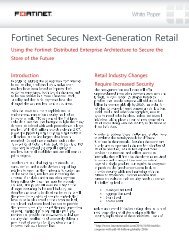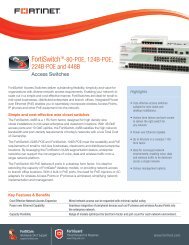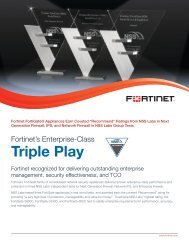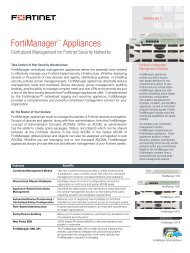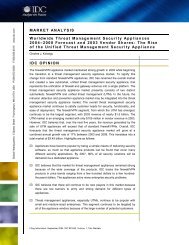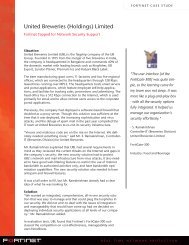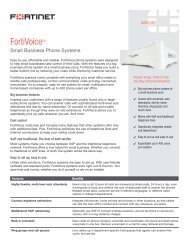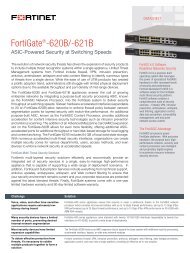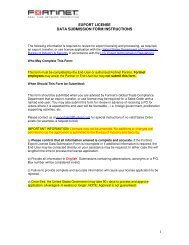FortiDDos DDoS Attack Mitigation Guide - Fortinet
FortiDDos DDoS Attack Mitigation Guide - Fortinet
FortiDDos DDoS Attack Mitigation Guide - Fortinet
You also want an ePaper? Increase the reach of your titles
YUMPU automatically turns print PDFs into web optimized ePapers that Google loves.
Granular rate limiting<br />
Granular rate limiting<br />
<strong>DDoS</strong> attacks are unpredictable and usually managed using scripted BOTs. The<br />
packets which reach the server are different from each other. There is however some<br />
self-similarity among all attack packets in a single attacks.<br />
Granular Rate Limiting is a technique that identifies rate violations from past behavior.<br />
Rate thresholds are set based on past behavior set during a training session and<br />
adjusted adaptively over time.<br />
Granularity refers to various parameters available in layer 3, layer 4 and layer 7<br />
headers. These include packet rates for source, destination, protocol, fragment, ports,<br />
and HTTP methods, URLs, User-Agents, Cookie, Host, Referer etc.<br />
White-list, black-list, non-tracked sources<br />
State anomaly recognition<br />
Stealth attack filtering<br />
Dark address scan prevention<br />
In any network, there will always be some IP addresses that you want to deny or allow.<br />
White-listing and Black-listing capability are useful during <strong>DDoS</strong> attack to ensure that<br />
such rules are honored despite rate violations or in spite of rate-violations.<br />
Since rate anomalies are behavioral, all behaviors are learned from past. Therefore if<br />
you don't want some behavior not to be learned, you must not track such behavior by<br />
creating an exception. Such non-tracked sources include backup IP machines etc. that<br />
do large amounts of IOs at specific times or Content Data Network (CDN).<br />
TCP is most commonly used protocol for web infrastructure. TCP is a stateful protocol<br />
and follows certain rules. Since most bots are scripted, many a times, they break these<br />
rules. A state anomaly recognition engine looks for illegal TCP state transition<br />
anomalies, foreign packets (packets in connections that are not properly established)<br />
and TCP window-violations.<br />
Before an attack, there are precursors to attacks. These are in the form of scans.<br />
Network scans to discover IP addresses in use are common and so also Port Scans to<br />
discover TCP and UDP ports that respond to connections. By identifying, such attacks<br />
and corresponding attackers, you can take some precautions for a future full-blown<br />
attack.<br />
Dark addresses are IP addresses that are not yet assigned by IANA. These are also<br />
called bogon addresses. Any packets coming from or going to dark addresses are<br />
signs of spoofing. By blocking them, you can block a substantial percentage of <strong>DDoS</strong><br />
packets that are spoofed.<br />
Forti<strong>DDoS</strong> <strong>DDoS</strong> <strong>Attack</strong> <strong>Mitigation</strong> <strong>Guide</strong><br />
28-100-167076-20120501 14<br />
http://docs.fortinet.com/ • Feedback


